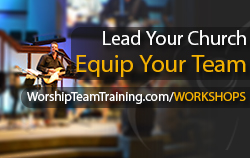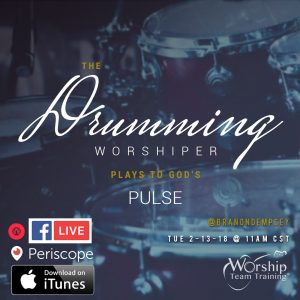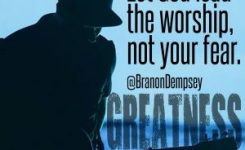Leaders, WTTU Special Public Post
Show #154 | “How to Speak Drum ” 2-13-18
Time: 30m video
#Communication #SpeakDrum
As a #WorshipLeader, do you struggle communicating with your #drummer? Do you know what sound you want to create, but hit a road block when it comes to conveying that sound to your drummer with words?Many times our attempts to speak “drum” end up sounding like a poor version of beat box sounds coming from our mouths that don’t help the situation at all.
Learn how to communicate with your drummer in terms that make sense. to them, and use your “drum language” fluently.
2-13-18 WATCH SHOW #154
Also Watch Live by: FacebookLive or Periscope
What to Do As a Leader:
First off, learn the language. Every instrument has a method and a style of communication. Drums are no different. Speaking drum is not a second class engagement or a “do this / do that” madness.Your drummer is the most critical person of the worship band. Between the leader and the drummer, there should be a level of respect and esteem. I should know as both a worship leader and a Promark Endorsee Teacher for twenty years.
Trust The Experts
Recently, I spoke with a worship leader that was frustrated with their drummer. It was the kind of situation where he could not get what he wanted. Added, the drummer was getting frustrated and the two of them began to rail each other. I offered this advise: Get a book on drumming, Youtube some good well known drummers such as: Tony Williams, Jack Deshonette, Greg Bissonette, Buddy Rich and Zoro the Drummer, and familiarize yourself with the instrument.Know Your Parts
Here is a medium sized kitchen sink of terms with explanation of equipment and purposes.Generic Sticks and Accessories: 5A’s – Most common multi purpose stick for all styles 7A’s – Light stick for jazz, latin and pop 9A’s – Medium stick for jazz, latin and pop 5B’s – Heavy stick for power and rock Wire Brushes – light/airy use for jazz, latin and effects Nylon Brushes – medium use, a bit more body and
Hot Rods: bounded small, medium to large dowel rods for a half plastic brush and stick sound.
Broom Brushes: real brush bounded whiskers that you find on your kitchen broom, to give a whisk/soft sound.
Soft / Felt Mallets: made out of sheep skin, yarn or fabric for cymbal rolls or used for dampen dark tones on snare and toms
Rubber or Medium – Hard Mallets: made from rubber or yarn with a dense core for tom and cymbals. Use with caution and sensitivity because they can rip drumheads.
Drum Heads: like drum sticks, there are a countless variety of soft, medium to hard heads for snare, kick and toms. Basically, the thinness to the thickest will produce light to full sounds and eq, as well as rebound response. When tuning, lose heads are lower pitched, while tighten heads raise the pitch.
There’s no one-way rule to tune/pitch the drum; it varies for every drummer and for what the song may call. The top head (batter) produces the rebound response and attack, while the bottom head produces the tone and dynamic. Generally, tune the top first for tension, tune the bottom next for tone. Tune both to tweak. Tuning is accomplished by a drum key, when fastened to a drum nut/lug. Use a clockwise pattern, tiny turns 1/8 to 1/4 per lug around the drum evenly – or – use a star pattern which is tuned from lug to lug at opposite ends of the head, making a star pattern.
Hi-Hat: the two small cymbals that close together, next two the snare drum
Closed Hat: when both cymbals are closed tightly (by the foot pedal) to produce the “chick” sound
Sizzle Hat: when the cymbals are opened by the pedal about 1/4 to produce a “sizzle” sound
Slosh Hat (or Half Hat): cymbals are 1/2 open to produce a “sloshing” sound
Open Hat: cymbals are all the way open to produce a “wash” sound
Foot Pedal: the device that is operated by the foot, from heal to toe in a closing/open pattern to manipulate the cymbals
Pedal Hat: when the foot clamps the cymbals down tightly on beat to mimic the snare – giving a “chuk” sound
How to use the High-Hat: there are may ways to play the Hi-Hat along with the open effects. Normally, the two cymbals are closed as the player hits with the sticks in playing a pattern: quarter notes, eights, sixteenths and other variations.
Opening the pedal a bit during the pattern can be used as a fill. Depending on how much you open the hat, determines the tone, brightness and volume projected. If the drummer plays sizzle or slosh hat, the cymbals will ring continuously until they are closed.
Example: X’s indicate “closed”; O’s indicate “open”.
8th note Pattern on closed hat with open fills in 4/4 time: xxxx xxxo xxxx xxxo
[ctt template=”6″ link=”7Pl1I” via=”no” ]Psalm 149:3 – “Praise His name with dancing, play drums and harps in praise of him” (GNT).[/ctt]
Taking the Time will Pay Off
Taking the time needed to learn the vocabulary that your drummer uses will result in two very happy people – the worship leader and the drummer! The drummer is relieved to finally understand what the worship leader is saying, and can meet the expectations of the worship leader. The worship leader is pleased because now communicating with the drummer is effortless, and the results speak for themselves.@BranonDempsey @worshiptt @WorshipTTU
Want to watch MORE Worship Team Training Videos?
Not a WTTU Member, or Choose to Upgrade? Update Now
 Worship Team Training® Is your worship team stuck? Want worship leading to be better? Want to be free? We can take you there. Inspire, create and transform the leading of worship. Get a WeekendWorkshop
Worship Team Training® Is your worship team stuck? Want worship leading to be better? Want to be free? We can take you there. Inspire, create and transform the leading of worship. Get a WeekendWorkshopCopyright 2017 Worship Team Training®










